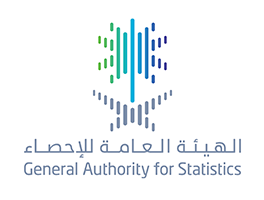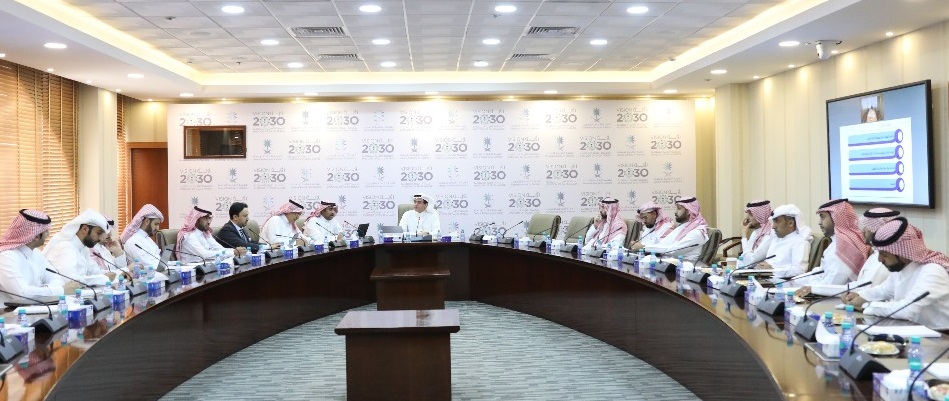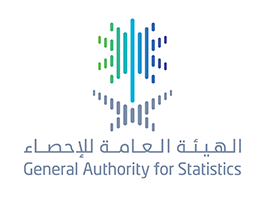
بوابات مكة تستقبل الحُجَّاج بـ " الأمن " و " الإحصاء "
With integration and coordination between GASTAT and the road security special forces
Makkah Receives Pilgrims with "Security" and " Statistics"
The General Authority for Statistics and the Road Security Special Forces in Makkah region clarified that all entry ports in Makkah are ready to receive pilgrims starting from the first hours of the first day of Thu-Alhijja, 1439 H. They added, great efforts have been made both financially and physically to facilitate the pilgrims' entry process. " Statistics" and " Road Security Special Forces" asked all pilgrims to provide their data accurately and clearly once they reach Makkah official entry ports.
This was discussed during the coordinative meeting which was held on Saturday Thu-alqida 29, 1439H in the services center in Alshimaisi Alsare'a between GASTAT leaders and the Road Security Force in Makkah region. The attendants of the meeting included GASTAT president, Dr. Fahad bin Sulaiman Altekhaifi and the operation division director in the Road Security Force in Makkah region Colonel Faisal bin Saad Alju'aid, who confirmed that all security entities are highly prepared for implementing the Hajj instructions in all roads and entry ports to make the entry process quick and easy, especially in the rush days which are usually the seventh and eighth days of the Thu-alhijja. All vehicles will be received by the road security special forces to make sure they have Hajj license. Then the General Authority for Statistics begin the task of pilgrims enumeration in the main centers surrounding Makkah: (Makkah/ Jeddah highway) center, ( Makkah/ Jeddah old way) center, Tane'em center, Sharae'a center, the South center, and the supportive centers in Medina and Taif.
On his part, GASTAT deputy of operations, methodologies and supervisor of the Hajj statistics program, Mr. Fahd Al-Fuhaid, said that the cooperation and integration with the Special Forces had started early this year. The meeting came today to review the joint goal between the two sides which is serving pilgrims and facilitating their entry to the city of Makkah during these days with all the data required to implement the program of Hajj statistics. He added that the process of collecting information is conducted electronically in a way that does not exceed 30 seconds maximum to ensure the speed of vehicles entry, as the statistical researcher enter data of each car carrying pilgrims coming from inside Saudi Arabia, including: type of car, number of pilgrims distributed by gender and nationality. Then he registers data in an electronic form using tablets. The entered data are referred to the time and date of vehicle entry and coordinates of the data collection location. Then they add the data of pilgrims coming from outside Saudi Arabia that are taken from the Directory of Passports.
It is worth mentioning that in addition to the road security forces and the relevant security entities, there are some other entities participating in the implementation of security tasks at the entrances leading to Makkah such as the Hajj Security Command for Traffic Affairs, the General Directorate of Passports, the General Directorate of Prisons, and Security Aviation. All offices and branches of the road security special forces also participate in the mission of Hajj each in his specialty to control the fake Hajj campaigns in accordance with a comprehensive security system to implement the early legal procedures on all roads leading to Makkah. However, the General Authority for Statistics in coordination with all these entities counts and enumerates the numbers of pilgrims, as their work lasts until they announce the total number of pilgrims on the ninth of Thu al-Hijja.

د. فهد التخيفي: المملكة قلب العالم الإسلامي وخدمة الحجاج شرف واعتزاز
GASTAT continues its preparations for the 1439H Hajj statistics
Dr. Fahad Altekhaifi: Saudi Arabia is the Heart of the Islamic World, and Serving Pilgrims is an Honor
The president of the General Authority for Statistics (GASTAT) announced that the authority is still preparing for the Hajj statistics program for this year 1439H. these preparations aim at providing detailed and accurate statistics, data, and information about the numbers of pilgrims coming from inside and outside Saudi Arabia. These works will be done through seven main centers in Makkah, and three supportive centers in Medina, Jeddah, and Taif.
Dr. Fahad bin Sulaiman Altekhaifi said that GASTAT with all its financial and humanitarian potentials, along with many governmental entities, is implementing the directions of the custodian of the two holly mosques and his crown prince- may God protect them- to provide all pilgrims with the services they need in order to make them feel comfortable, as Saudi Arabia is honored to serve them and facilitate their Hajj steps every year. Saudi Arabia represents the heart of the Islamic world, and serving pilgrims is an honor. Therefore, all Saudi public and private entities are competing to provide whatever they can do to make the Hajj season a successful one. He added, we, the people of Saudi Arabia, recognize what does it mean to be the only country that organizes a very important Islamic pillar.
Dr. Altekhaifi clarified that GASTAT is implementing the Hajj statistics through three main tracks; the first one concerns pilgrims coming from inside Saudi Arabia (from all Saudi regions to Makkah). In this track, GASTAT uses the comprehensive enumeration method, which counts all arrivals who come to Makkah for the purpose of Hajj. It is conducted through all Hajj statistics main centers located in Makkah entry ports. The president indicated that all main centers are located in the entry ports of Makkah and surrounds it from all sides, except for the one located in the center of Makkah.
GASTAT employees are found, along with the concerned entities of the ministry of interior, in (Makkah/ Jeddah highway) center, which is the biggest and most important center, as it represents the main way taken by pilgrims who come from Jeddah city. They are also found in (the old way between Makkah and Jeddah) center, Tan'em center, Shara'ea center, Alkar center, and the south center. However, GASTAT can be also found in some supportive Hajj statistics centers which are located in Medina, Jeddah, and Taif, especially in the domestic pilgrims' parking, airports, public transport stations, and the Meeqat spots. The second track is for pilgrims coming from outside Saudi Arabia (pilgrims who come from outside Saudi Arabia to Makkah through all air, land, and sea ports. To count those pilgrims, GASTAT depends on the pilgrims data received from the concerned entities, distributed by gender, nationality, date of arrival, and way of arrival. However, the third track concerns pilgrims coming from Makkah. GASTAT estimates the numbers of those pilgrims depending on the periodical field surveys conducted by GASTAT among a sample of households from Makkah in order to determine the percentage of pilgrims who come from Makkah.
As for the mechanism of pilgrims' numbers enumeration, Dr. Fahad Altekhaifi stated that GASTAT staff will be present in the Hajj statistics centers located in Makkah entry ports, so that they can count all arrivals who come for the purpose of Hajj. The works will begin on the first day of Thu Alhijja, 1439H. the staff will register the data of every car that carries pilgrims coming from inside Saudi Arabia. The data will be registered on an electronic form by using tablets. They include the car type, number of pilgrims distributed by gender and nationality. The data have a time reference which is the time and date of entry, and a spatial reference which is the coordinates of the data collection location. After that, the information will be transferred to the entry centers' databases through transferring systems. Then a synchronization of data is made between the tablets and the centers' databases. Finally, data are transferred to the main database in Makkah, where data are processed, and daily reports and Hajj statistics bulletins are written.
It is worth mentioning that the task of pilgrims' enumeration has been done by GASTAT since 1390 H. this task aims at providing accurate information that helps all governmental entities in planning and developing the pilgrims services. This task is still performed by GASTAT with many improvements in the methods of enumeration to make them more accurate and comprehensive.
Saudi Arabia was pleased to serve 54 million pilgrims during the last 25 years
GASTAT conducts annual enumeration for pilgrims
Saudi Arabia was pleased to serve 54 million pilgrims during the last 25 years
According to GASTAT’s official statistics, the total number of pilgrims who were served by the Kingdom of Saudi Arabia during the last twenty-five years reached (53.928.358) pilgrims. The lowest number of pilgrims was registered in the Hajj season of 1415 H where the number of pilgrims reached (1.781.370). On the other hand, the highest number of pilgrims was registered in 1433 H where the number of pilgrims reached (3.161.573) pilgrims. Additionally, during the last ten years the number of pilgrims reached (23.834.151) pilgrims.
GASTAT spokesman, Taiseer Almofarrej said that counting the numbers of pilgrims each year is one of the important tasks performed by GASTAT. This task has started since 1390 H in order to provide accurate information that would help all governmental entities to plan and develop the services provided to pilgrims. However, the task has been performed for many years, with a lot of developments in the methods of counting and enumeration so that they can be applied in an accurate, comprehensive, and professional way.
Mr. Almofarrej added that the Hajj statistics program aims to complete all programs of future plans for the purpose of providing the necessary services for the pilgrims, whether social, health, security, food or transportation services. It is done by using a time series of accurate data on the numbers of pilgrims, the estimates of manpower needed to serve the pilgrims and to maintain their safety and comfort during the Hajj season of each year. The data and numbers of pilgrims are used by the entities concerned with the study of the preparations and the main facilities in Makkah and the holy places and taken into account when preparing the necessary plans. In addition, it provides accurate information and data about hajj statistics for researchers, students, beneficiaries and those interested in this field. Furthermore, the data on the number of pilgrims is used in the evaluation of the activities and events conducted by the entities concerned with serving the pilgrims, as well as to identify ways of arrival of the domestic pilgrims and the pilgrims coming from outside the Kingdom.
The official spokesman of the General Authority for Statistics revealed that the statistics of the services provided by government agencies to pilgrims will be announced periodically from the first of Dhu al-Hijjah. Furthermore, the Authority will release the final and official number of pilgrims on the evening of 9th of Dhu al-Hijjah, through the Hajj statistics bulletin in details which includes: number of pilgrims inside, number of pilgrims outside, number of pilgrims by sex, nationality and destination, number of vehicles transporting pilgrims as well as types, and other detailed data.
It is worth mentioning that during the previous 25 years, the number of pilgrims exceeded three million pilgrims once, while exceeding more than two million pilgrims twelve times. On the other hand, it fell from two million pilgrims during twelve seasons, and the lowest was recorded in 1415, according to the following table.
Numbers of pilgrims during the past 25 years
S
Year
Total number of pilgrims
1
1414H
1.834.780
2
1415H
1.781.370
3
1416H
1.865.234
4
1417H
1.942.851
5
1418H
1.832.114
6
1419H
1.831.998
7
1420H
1.839.154
8
1421H
1.913.263
9
1422H
1.944.760
10
1423H
2.041.129
11
1424H
2.012.074
12
1425H
2.164.469
13
1426H
2.258.050
14
1427H
2.378.636
15
1428H
2,454,325
16
1429H
2,408,849
17
1430H
2,313,278
18
1431H
2,789,399
19
1432H
2,927,717
20
1433H
3,161,573
21
1434H
1,980,249
22
1435H
2,085,238
23
1436H
1,952,817
24
1437H
1,862,909
The General Authority for Statistics (GASTAT) Released the Real Estate Price Index, Q2, 2018
The General Authority for Statistics (GASTAT) Released the Real Estate Price Index, Q2, 2018
On Sunday, the 16th of Dhu al-Qa'dah 1439H corresponding July 29, 2018, The General Authority for Statistics (GASTAT) released the report of Real Estate Price index, Q2 2018 on GASTAT official website www.stats.gov.sa.
The real-estate price index has recorded a decline by (7.0%) compared to the previous quarter (Q1, 2018), where the indicator of the Real Estate Price index reached (83.6) in the second quarter of 2018 compared to (84.2) in (Q1, 2018). This decline can be attributed to the decrease in the main sectors composing it: the housing sector (8.0%), the commercial sector (4.0%), and the agricultural sector (1.0%) compared to the first quarter of the current year.
At the level of the residential sector in details, the second quarter of 2018 witnessed slight decreases compared to the previous quarter, where the residential land decreased by (0.9%), the villas decreased by (1.7%), the apartments decreased by (0.6%), while the houses decreased by (0.1%). On the other hand, residential buildings increased by (0.2%). Regarding the commercial sector, commercial plots decreased by (0.4%), compared to the previous quarter. However, the agricultural sector witnessed a decrease by (0.1%). in agricultural lands.
Furthermore, the index is based on the data records about real-estate’s transactions available at the Ministry of Justice, and it is an important tool to support economic and statistical decision makers regarding the changes of property prices and future forecasts during different periods of time. The index has three main sectors consisting of several types of real estate: housing sector which includes the following (plot of land, building, villa, apartment and house), commercial sector includes (plot of land, building, exhibition/commercial center and shop), and the agricultural sector with only one category which is the agricultural land.

الهيئة العامة للإحصاء تصدر تقرير نتائج مسح صحة الأسرة 2017م
Containing more than 85 Indicators of Household Health in the Kingdom
GASTAT Releases the Results of the Household Health Survey 2017
On Thursday, Dhu al-Qidah 13th, 1439H. (Corresponding to July 26th, 2018) the General Authority for Statistics (GASTAT) released the results of the Household Survey (2017) on its official website (www.stats.gov.sa) as part of the results of the new surveys issued by GASTAT. This survey is the first survey in the field of household health, which was carried out during the period from (21/2/1439H. to 15/3/1439H.) corresponding to (10/11/2017 to 3/12/2017). It is one of the most important sources of data needed for development planning in the health and social fields at the national level. The bulletin includes more than 85 indicators on health and social phenomena and on family health in the Kingdom.
The results showed that 94.2% of the population at the age group (15 years and above) have good or very good health according to their personal assessment of their health. Regarding Saudi population, the percentage of Saudi males who have good or very good health reached 93.5%, whereas the Saudi females reached 91.7%. The results also showed that 25.4% of the population at the age group (15 years and above) undergo a periodic medical check-up to check their health at least once a year. While the percentage of population who are covered by a health insurance reached 37.1% of total population, 13.9% of them are Saudis and 75.4% are non-Saudis.
The results also showed that the percentage of population who suffer from chronic diseases diagnosed by a doctor at the age group (65 years and above) is the highest for both males and females. The percentage in this group is 73.8% for females compared to 67.8% for males. The percentage of population who have been diagnosed with diabetes by a doctor reached 8.5% of the Kingdom population, the males diagnosed with diabetes reached 8.7% and 8.3% for females. The percentage of Saudi population who have been diagnosed with diabetes reached 10.1%, 10.4% for Saudi males and 9.8% for Saudi females.
The percentage of population (15 years and above) who have been diagnosed with cancer disease reached 0.17%, whereas the percentage of population (15 years and above) who have been diagnosed with cardiovascular diseases reached 1.14%. The results of the survey also showed that the total fertility of Saudi females reached 2.35%, while the total fertility rate in the Kingdom is (2) births per one woman in the Kingdom. The percentage of births performed by specialized doctors was 99.7%.
It is worth mentioning that this survey was conducted in accordance with the international standards recognized by the World Health Organization and the United Nations. The results will enable specialists to study many health phenomena, extract many indicators related to health in the Kingdom, as well as maternal and child indicators, and indicators about health lifestyle in the community. It also provides data about smoking, the size of accident injuries, as well as the study of marriage, family planning, fertility and child mortality. For comparison purposes and in order to unify the statistical method and style in the implementation of the household health surveys, all 13 regions of the Kingdom were covered through a representative sample of households.

فرق عمل "اللجنة التنسيقية للهيئة العامة للإحصاء" تبحث طرق تبادل البيانات بين الجهات الحكومية
With the participation of 31 government entities over a period of 5 days
The Task Teams of the (Coordination Committee of the General Authority for Statistics) discuss ways of exchanging data between government entities
Within the framework of the General Authority for Statistics' efforts to facilitate and exchange data and information with various government agencies, the coordination committee meetings of the Coordination Committee of the General Authority for Statistics took place during the five days from July 1st to 5th , 2018, with the participation of 31 government entities.
The official spokesman of the General Authority for Statistics, Tayseer Al-Mufrrej, explained that the coordination teams discussed several topics, including the discussion of the general frameworks for the coordination work between the various entities in the joint works. They also reviewed the challenges and obstacles facing the task teams and discussed the appropriate solutions. In addition, they reviewed the statistical work carried out during the last period. The government agencies also made a number of development proposals for data dissemination and raising statistical awareness, in addition to data exchange.
On the other hand, Mr. Al-Mufrrej said that the Coordination Committee of the General Authority for Statistics includes a number of coordination teams, including the coordination Task team for Economic Statistics, which includes, the Ministry of Economy and Planning, the Ministry of Health, the General Authority for Sport, the Ministry of Trade and Investment, the Ministry of Labor and Social Development , Ministry of Energy, Industry and Mineral Resources, Ministry of Finance, Council of Saudi Chambers, Saudi Customs, General Authority for Investment, Saudi Arabian Monetary Agency, General Authority for Tourism and National Heritage, and Small and Medium Enterprises Authority.
The coordination task team on Environment Statistics includes: The Ministry of Municipal and Rural Affairs, the Ministry of Environment, Water and Agriculture, the General Authority for Meteorology and Environmental Protection, Saline water conversion Corporation and the Royal Commission for Jubail and Yanbu.
The coordination task team on Energy Statistics includes: The Ministry of Energy, Industry and Mineral Resources, the Saline Water Conversion Corporation, King Abdullah City for Atomic and Renewable Energy, the Ministry of Energy's National Renewable Energy Program, the Royal Commission for Jubail and Yanbu and the Electricity & Co-Generation Regulatory Authority.
The coordination task team of Masdar program includes: The Ministry of Health, Ministry of Housing, Ministry of Commerce and Investment, Ministry of Education, Ministry of Municipal and Rural Affairs, Ministry of Environment, Water and Agriculture, Ministry of Civil Service, Saudi Arabian Monetary Agency, General Organization for Social Insurance , The Public Pension Agency , the General Auditing Bureau, the Yesr Program, the National Information Center of the Ministry of the Interior, the Ministry of Justice, the Ministry of Economy and Planning, the Ministry of Finance and the Ministry of Labor and Social Development.
While the coordination task team of the social statistics includes: The Ministry of Justice, the Ministry of Housing, the Ministry of Labor and Social Development, the Ministry of Health, the Ministry of Municipal and Rural Affairs, the Public Prosecution, the Ministry of the Interior, the Ministry of Civil Service, the Ministry of Education and the Saudi Post.
It is worth mentioning that the meetings were held as preparatory meetings for the meeting of the Coordination Committee of the General Authority for Statistics, which will be held on the tenth of next September. The "Coordination Committee" was formed permanently to coordinate the statistical work between the General Authority for Statistics and related entities, in accordance with the decision of the Council of Ministers (11) dated 13/1/1437 AH on the organization of the Commission, aimed at activating and organizing the statistical work through the establishment of a comprehensive, accurate and unified statistical system, in addition to the follow-up of its implementation. It also develops the plans and programs necessary to meet statistical needs; in order to serve the developmental plans, scientific research, and various activities.

الهيئة العامة للإحصاء: ارتفاع في مُعدَّل المشاركة الاقتصادية للسعوديين، و (6.1٪) مُعدَّل بطالة إجمالي السكان، وبطالة السعوديين: (12.9٪)
A decline in the numbers of non-Saudi workers by more than 234 thousand during Quarter 1, 2018
GASTAT: Saudis economic participation rate increased, total population unemployment rate is (6.1%), and Saudis unemployment rate is (12.9%)
The General Authority for Statistics (GASTAT) published on its official website www.stats.gov.sa the Labor Market Bulletin for the first quarter of 2018, which provides comprehensive data and indicators on the labor market in Saudi Arabia from the estimates of the labor force survey conducted by GASTAT quarterly, in addition to the labor market data from the administrative records of some relevant entities (Ministry of Labor and Social Development, Ministry of Civil Service, General Organization for Social Insurance, Human Resources Development Fund and National Information Center).
The results of the bulletin for the first quarter of 2018 indicated that the total number of workers from the data of administrative records in Saudi Arabia (Q1, 2018) reached (13,333,513) individuals, compared to (13,581,141) individuals in Q4, 2017. However, the first quarter of 2018 witnessed a decrease in the numbers of non-Saudi workers by (234,191) individuals compared to the fourth quarter of 2017, as they registered (10,183,104) individuals in Q1, 2018 compared to (10,417,295) in Q4, 2017. On the other hand, the numbers of Saudi workers registered (3,150,409) individuals.
As for the rate of population’s economic participation (15 years and older), it recorded (55.5%) in Q1, 2018 compared to (55.6%) in Q4, 2017. However, the economic participation rate of Saudis increased by (41.89%) compared to (41.86%) in the previous quarter. Saudi males’ economic participation (15 years and older) increased by (63.5%) compared to (63.4%) in the previous quarter, whereas Saudi females’ economic participation (15 years and older) increased by (19.5%) compared to (19.4%) last quarter.
The results also showed that the rate of population’s unemployment (15 years and older) reached (6.1%) during the first quarter of 2018 compared to (6.0%) in Q4, 2017. Saudis unemployment rate (15 years and older) registered (12.9%) in the first quarter of 2018, but the Saudi females’ unemployment rate has decreased during this quarter registering (30.9%) compared to (31.10%) in Q4, 2017. In contrast, Saudi males’ unemployment rate registered an increase with (7.6%) compared to (7.5%) in Q4, 2017.
In addition, the total number of Saudi jobseekers from the estimates of administrative records (Jadarah, Sa’ed, and Hafiz programs) reached (1,072,162) individuals during the first quarter of 2018 compared to (1,086,561) individuals with a decline by (14,399) individuals from last quarter. Saudi male job seekers recorded (16.1%), while female jobseekers recorded (83.9%).
The bulletin included a large number of detailed data on workers according to the regulations they are subject to, and according to the nationality, gender, age, administrative region and educational level, as well as data on job seekers, average monthly wage, working hours and domestic workers.
On the other hand, GASTAT spokesman Mr. Taiseer Almofarrej, clarified that there is a difference between job seekers and unemployed. The "unemployed" according to the Labor Force Survey are the individuals (15 years and older) who were jobless during the period of the time reference (the survey period): the previous week of the household visit and have been looking for a job seriously during the four weeks prior to the household visit (they have at least taken one way to look for a job). This includes those who did not search for work during the four weeks prior to the household visit because they were waiting for a job or starting their own business in the coming period, where they had already been looking for work before the time reference period and at the same time they were able to work and were ready to join it (If available), during the week preceding the household visit.
Additionally, the definition of job seekers is the Saudi individuals (males or females) enrolled in the job search programs of the Ministry of Civil Service (Jadarah or Sa’ed) and the Human Resources Development Fund (Hafiz). And they register their personal data, qualifications, practical experiences and CVs through an electronic system.
It is worth to mention that job seekers in the administrative records are not subject to the internationally recognized standards and conditions of unemployment approved by the ILO and therefore are not considered to be unemployed. Hence, not every job seeker is considered unemployed, s/he may be looking for work and is working in another job, this is the case in job seekers in government entities who are working, for example, in the private sector.

الهيئة العامة للإحصاء تُجري 5 أعمال إحصائية ميدانية الأسبوع المقبل
Targeting more than 35,000 households and 53,000 Establishments
The General Authority for Statistics is conducting 5 field statistical works next week
The General Authority for Statistics (GASTAT) has invited all citizens and residents, as individuals or in corporations, to cooperate with the statisticians working in the field in various regions of the Kingdom of Saudi Arabia, who their statistical work will start next Tuesday Shawwal 26th,1439AH (July 10th, 2018). GASTAT asserted that all information and data given by citizens, residents and corporations is confidential and will be treated as an information basis which is reliable and can be used by development decision-makers in all relevant government entities that will serve the interest of citizens and residents.
GASTAT spokesman, Mr. Taiseer Almofarrej said that more than (1600) statisticians are conducting 5 social and economic statistical surveys during this period until Dhu Al-Qidah 20th, 1439 AH (August 2nd, 2018). These statistical works are targeting more than 35,000 households and 53,000 establishments in all (13) administrative regions. He mentioned that the field surveys of the economic indicators are used by the decision makers who are involved in the unemployment issue and increasing the employment in the internal trade activity. In addition, the recent statistical data contribute to the knowledge of the volume of internal trade activity and the measurement of its contribution to GDP. He pointed out that the Labor Force Survey helps to extract real indicators and data on unemployment, workers and the economic participation in the Kingdom, as well as data on labor force for the population (15 years old and above). This survey is one of the household field surveys based on a sample, conducted by GASTAT in the field of social statistics. He added that these data are important in terms of giving a picture of the size of the labor force among the working age population of male and female, active and economically inactive.
Mr. Almofarrej mentioned that the field surveys that will be conducted by GASTAT next week by statisticians who are holding official ID cards includes: Industrial Production Survey (3rd quarter, 2018), Economic Indicators Survey (3rd quarter, 2018), Internal Trade Activity Survey (3rd quarter, 2018), Construction Activity Survey 2018, and Tourism Survey 2018.
